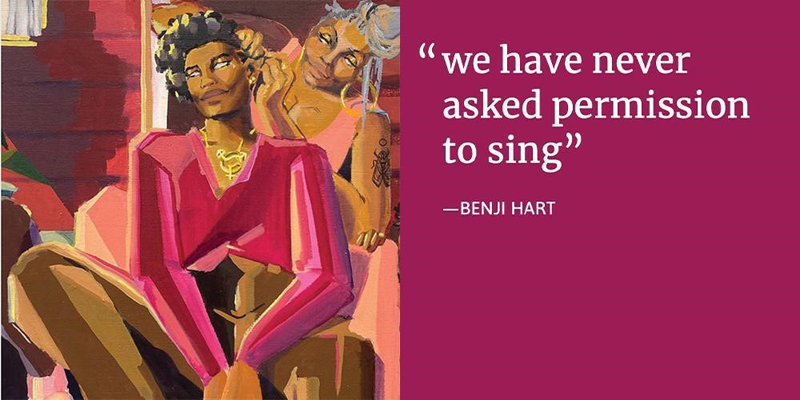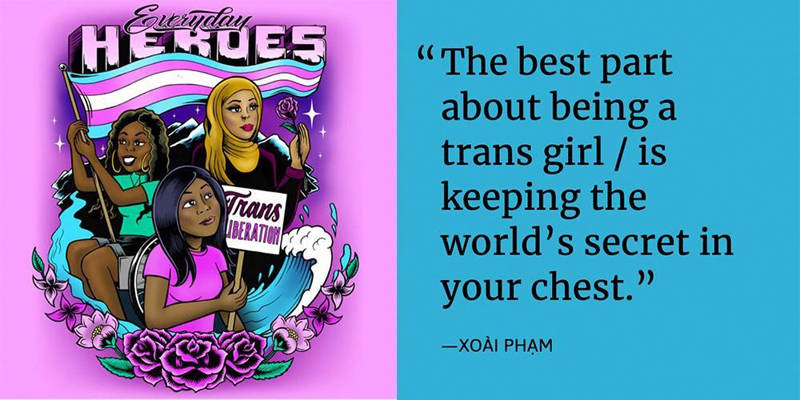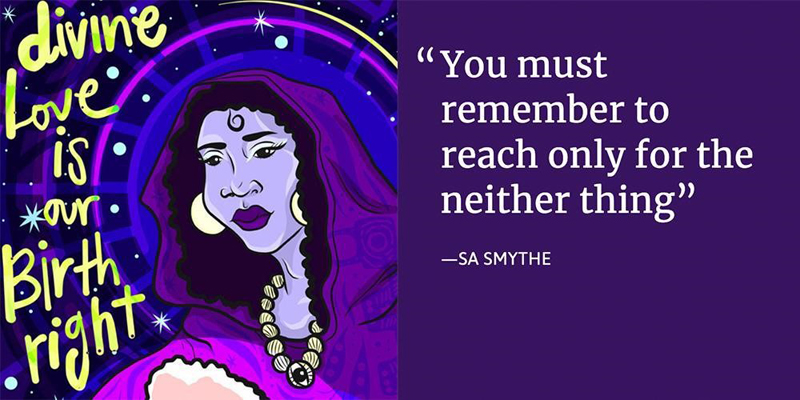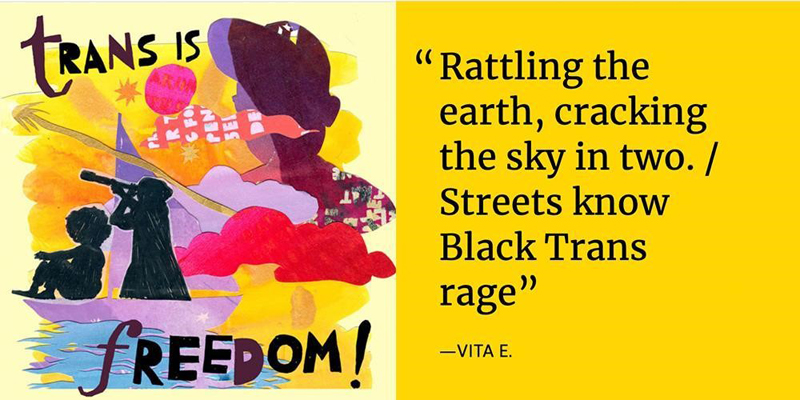Art Is a Tool of Resilience for Trans People
I am proud to be one of ten trans artists of color who contributed to this year's Trans Day of Resilience art project, an extension of Trans Day of Remembrance.
![[Photo: An illustration of black trans individuals sitting on a porch. One person braids the hair of another.]](https://rewirenewsgroup.com/wp-content/uploads/2019/11/GloriTuitt-Rewire-800x533.jpg)
I wake with a heavy heart on November 20, Trans Day of Remembrance. I’m reminded that, at 24 years old, I’m lucky to have lived this long. My sisters Claire Legato, Muhlaysia Booker, Paris Cameron, Chanel Scurlock, Zoe Spears, Tracy Single, Kiki Fantroy, and Bee Love Slater are all Black trans women who were murdered before they saw 24. Bailey Reeves was just 17.
This year, thanks to the moving work of the Trans Day of Resilience art project, I see more clearly how important it is that we mourn those we’ve lost while celebrating how our communities remain resilient. Trans communities need people not only to grieve but also to invest in our visions for liberation—because it’s about your liberation too.
Each year, time goes by with just a few days in between news of another one of our family being killed. And on top of that, the Trump administration has made it a point to actively attack trans communities by undermining the enforcement of our rights in health care, housing, and employment.
In migrant prisons, trans women like Roxsana Hernández and Johana Medina León are neglected and targeted for abuse. Hernández died in federal immigration custody, while Medina León died shortly after she was released following what her family described as “negligent” care.
Employers and health-care providers also regularly mistreat trans people living with HIV and those of us with disabilities, leading to high rates of homelessness and poverty. And the police profile and assault us after assuming we’re sex workers.
The violence we are subjected to harms not only our bodies; our spirits are constantly under attack. Violence against trans communities is meant to chip away at our collective resolve.
I believe trans people are targeted because we reflect a part of humanity that people are afraid of. We have been around since before this administration came into power. We’ve been around since before the formation of the United States. In every corner of the world, we have thrived before the word “trans” even existed! We have taken on the titles of bakla, hijra, māhū, fa’afafine, nádleehi, akava’ine, muxe, sekrata, quariwarmi, and more. We have had sacred roles in our communities because many of us carry the divine ability to see beyond the limited binary of male and female.
Trans people come from a celestial legacy. We are in the trees, the stars, the wind, and water. We reflect a part of humanity that people refuse to acknowledge because they are afraid of themselves. Our existence simply expands humanity to greater depths.
Trans communities of color have built our own versions of home, family, health, and work. Our ancestors made livelihoods out of nothing. Despite being denied resources at every turn, we have planted the seeds needed to quite literally house one another, become one another’s family, heal each other’s wounds, and help our people get money, by any means necessary. We find home in each other.
As with every movement for justice, artists are integral to defining the pain and joy of trans communities. We are essential to preserving memory and articulating the demands of our people. We imagine and construct the world that we all deserve to live in.
I am proud to be one of ten trans artists of color who contributed to this year’s Trans Day of Resilience art project, an extension of Trans Day of Remembrance, which began in 1999. This annual project is spearheaded by Forward Together, a national women of color-led organization, whose mission is to unite communities to win rights, recognition, and resources for all families. Get into the magic below. In addition, you can read the Femifesto for Trans Liberation to understand the politics that catalyzed Trans Day of Resilience.
By engaging and supporting trans art, you are ensuring our movements for justice are sustainable. Celebrate our community’s resilience and share these artworks far and wide.

Art by Glori Tuitt. Poetry by Benji Hart. Their joint artist statement:
As artists—one of us a painter, the other a poet—our visions for trans liberation were united by our desire to center Blackness, and the challenge to imagine tangibly what a world post-incarceration might look, feel, taste like.
While Benji entered the project struck by and hoping to pay homage to the life of Layleen Cubilette-Polanco Xtravaganza—an Afro-Latina trans woman who died inside the Rikers Island prison complex in June—Glori was particularly interested in honoring Black, trans elders. She hoped to imagine aging-while-trans not as an anomaly but a right, and to capture the tension between Black trans intimacy and public defiance.

Art by Malachi Lily. Poetry by Mia S. Willis. Their joint statement:
We are the divine. Our love of mythology, passion for poetry and imagery, and a desire to push the boundaries of what it means to exist as a resilient trans/nonbinary person made us want to craft new mythologies for the Black, trans experience—and rewrite our cosmic birth. We did this together through sharing resources, and then poetry, which I used to create the imagery for this project. Though we aspire to do more in-depth, narrative works in the future, what we created was deeply personal. We were influenced by the other, but also inspired by ourselves and our own tools of resilience through shapeshifting forms, manipulation of time, and collectivity in our voice.
We are boundless and floating. Like a newly emerged dragonfly, we delight in our existence, the gentleness of plants, and the glisten of our reflection in the water’s surface. My hope is that people see themselves in these pieces. Strength in our delicate tenderness. That’s the resilience I crave. One that allows us to be soft and supple and sprouting. May you see yourself and know your divinity. Know you are loved.

Art by Shea Coco. Poetry by xoài phạm. Our joint statement:
Every day, trans femmes are told that we are unnatural. That we don’t belong in this world. Governments and people target us to tear down our bodies and spirits, to remove us from this world.
What we know is that trans femmes are nature itself. We have always been here, whether we’ve called ourselves trans or not. We’ve gone by many names and have played sacred roles in our communities across the world and throughout time. We are everyday heroes because we are still here. We are stewarding the movements that transform our world. Our resilience, imagination, love, and compassion is that of the natural world. We are in the trees, the wind, the stars.

Art by féi hernandez. Poetry by SA Smythe. Their joint statement:
Our calling to the divine, otherworldly, and the liminal spaces we live in informed how we embarked on our respective journeys for this project. How do we give a face, a name, a word to the multitudes that enhance our majestic power and beauty as trans Black, indigenous, and people of color around the world? We understood that in their unbordered livingness, our ancestors, animal guides, spirits, god(s) or source all carry various geographies, meaning, and knowledge, gracefully loving us in our totality through whispers, light pushes, and witnessing. This set a sparkling spiral of creative energy to flow between and through us. Our final works demonstrate our efforts to bridge the ancient, present, and future across time and space to reflect what we think is needed to support our collective imagining of another, more just and tender world.
We offer a poem and an art piece to help provide a sanctuary, a place to sit, to recognize that we are loved by our ancestors, held by divinity, and forevermore eternal. We hope that these bridges help us meet the long line of ancestors, the stars, the present living, and future generations in one place full of enduring love, lasting protection, and otherwise community.

Art by Kah Yangni. Poetry by Vita E. Their joint statement:
It was so hard to imagine a world where we’ve won, given all the death we’ve come to know for this year. This art became less about how we’ve “won,” but more about how we’re winning, and honoring what it took to make it here. It became more about the adventure and freedom and creativity that is already a part of being trans. Our work has the feeling of “outside the box” dreaming that’s manifested itself in our present day, not forsaking the past as forgotten, but honoring it as a tribute to the magick we’ve created.

